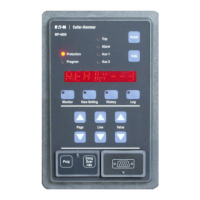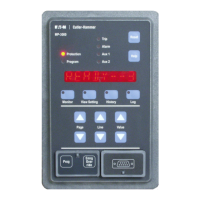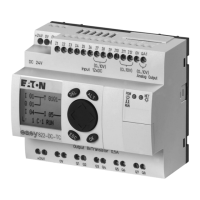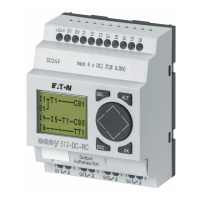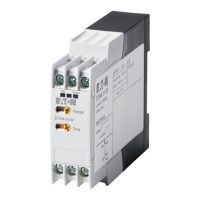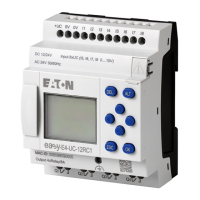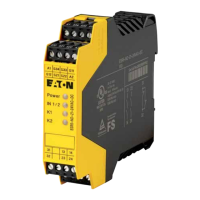IM02602002E
Page 8-2
www.eaton.com
MP-3000
Phasor analysis is used to determine the sequence currents from
physical phase current phasors.
Any 3-phase ac current without
external ground or neutral return path can be represented by the addi-
tion of I
1
and I
2
phasors in each phase. For an example, refer to the
unbalanced motor currents of Figure 8.3. In this case, the 3-phase
currents in the motor are I
A
, I
B
, and I
C
. Note that I
B
and I
C
are of about
the same magnitude as I
A
, yet are noticeably displaced in phase
position. This is an example of a serious negative sequence condi-
tion that is threatening to the rotor, yet is not reected in the current
magnitudes alone.
To calculate the positive sequence component in phase A, rotate the
phase B current phasor 120 degrees in the positive direction and the
phase C phasor 240 degrees in the positive direction (see Figure 8.4).
The formula for I
A1
is:
I
A1
= I
A
+ (I
B
120°) +( I
c
240°)
3
Note that these are phasor (vector) operations with a phasor result.
The positive sequence phasors in phases B and C have the same
magnitude as the phase A positive sequence phasor, but lag the
phase A component by exactly 120 and 240 degrees, respectively.
This balanced set of phasors drives the motor’s useful work.
To calculate the negative sequence component in phase A, rotate the
phase B current phasor 120 degrees in the negative direction and the
phase C phasor 240 degrees in the negative direction (see Figure
8.5). The formula for I
A2
is:
I
A2
= I
A
+ (I
B
-120°) + (I
c
- 240°)
3
The negative sequence phasors in phases B and C have the same
magnitude as the phase A positive sequence phasor, but lead the
phase A component by exactly 120 and 240 degrees, respectively.
This balanced set of phasors represents the net effect of magnitude or
phase unbalance and only heats the rotor.
Certain harmonics in the phase currents produce torques in the rotor,
just like positive and negative sequence currents. In particular, the 7
th
and 13
th
and certain higher harmonics act like positive sequence. The
5
th
, 11
th
, and certain other higher harmonics act like negative se-
quence. This can also inuence motor performance and heating. The
MP-3000 sequence calculations also capture these harmonic currents
and include their effect in the thermal modeling.
Prior to the use of a microprocessor in a multifunction motor protec-
tion relay, there was no reasonable way of modeling the total heating
effects of the positive and negative sequence components on a con-
tinuous basis. Therefore, oversimplied assumptions were used with
available relays. This resulted both in nuisance tripping and in motor
burnouts or life reduction. The MP-3000 uses a unique, patented
calculation for determining these values from current samples and
modeling their effects. The effective current squared, as used in the
calculation for rotor heating, is:
I
2
=
I
1
2
+
kI
2
2
Here,
I
2
is weighted by k because of the disproportionate heating
caused by the negative sequence current component. The effects
of both the positive and negative sequence currents are accurately
taken into account. Their combined effect is incorporated into a rotor
protection algorithm that effectively keeps track of the temperature of
the rotor.
It is not necessary to pick an arbitrary phase unbalance setting to trip
the motor, although such an unbalance trip function is additionally
included in the relay to speed up tripping without heating for grossly
unbalanced conditions. As long as the combined effect of the positive
and negative sequence currents does not approach the values in the
motor protection curve, the MP-3000 allows the motor to run.
The MP-3000 models heating as the lling of a thermal reservoir or
accumulating bucket whose size is determined by the thermal capac-
ity of the motor. This capacity is calculated in the relay from motor
nameplate constants. The lling is proportional to effective I
2
over
time, where effective I
2
includes the disproportionate heating effect of
negative sequence currents. Cooling is also modeled as draining of
the bucket. The loss of equilibrium between heating and cooling leads
to an eventual thermal trip. The thermal bucket lling in percent can
be observed continuously on the MP-3000 display, via data communi-
cations, or via the 4-20 mA transducer output.

